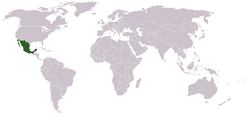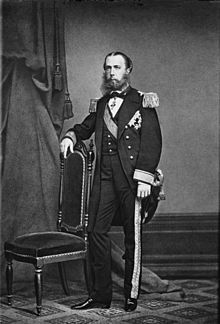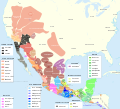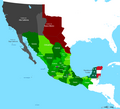Portal:Mexico
|
The Temple of Warriors at Chichen Itza, Mexico
¡Bienvenido! Welcome to the Mexico portal
Mexico, officially the United Mexican States, is a country in the southern portion of North America. It covers 1,972,550 km2 (761,610 sq mi), making it the world's 13th-largest country by area; with a population of almost 130 million, it is the 10th-most-populous country and the most populous Spanish-speaking country. Mexico is organized as a federal constitutional republic comprising 31 states and Mexico City, its capital. It shares land borders with the United States to the north, with Guatemala and Belize to the southeast; as well as maritime borders with the Pacific Ocean to the west, the Caribbean Sea to the southeast, and the Gulf of Mexico to the east.
This is a Featured article, which represents some of the best content on English Wikipedia.
 The Olmec colossal heads are stone representations of human heads sculpted from large basalt boulders. They range in height from 1.17 to 3.4 metres (3.8 to 11.2 ft). The heads date from at least 900 BC and are a distinctive feature of the Olmec civilization of ancient Mesoamerica. All portray mature individuals with fleshy cheeks, flat noses, and slightly-crossed eyes; their physical characteristics correspond to a type that is still common among the inhabitants of Tabasco and Veracruz. The backs of the monuments often are flat. The boulders were brought from the Sierra de Los Tuxtlas mountains of Veracruz. Given that the extremely large slabs of stone used in their production were transported over large distances (over 150 kilometres (93 mi)), requiring a great deal of human effort and resources, it is thought that the monuments represent portraits of powerful individual Olmec rulers. Each of the known examples has a distinctive headdress. The heads were variously arranged in lines or groups at major Olmec centres, but the method and logistics used to transport the stone to these sites remain unclear. They all display distinctive headgear and one theory is that these were worn as protective helmets, maybe worn for war or to take part in a ceremonial Mesoamerican ballgame. The discovery of the first colossal head at Tres Zapotes in 1862 by José María Melgar y Serrano was not well documented nor reported outside of Mexico. The excavation of the same colossal head by Matthew Stirling in 1938 spurred the first archaeological investigations of Olmec culture. Seventeen confirmed examples are known from four sites within the Olmec heartland on the Gulf Coast of Mexico. Most colossal heads were sculpted from spherical boulders but two from San Lorenzo Tenochtitlán were re-carved from massive stone thrones. An additional monument, at Takalik Abaj in Guatemala, is a throne that may have been carved from a colossal head. This is the only known example from outside the Olmec heartland. (Full article...)Selected article -Mexico City (Spanish: Ciudad de México, locally [sjuˈða(ð) ðe ˈmexiko] ⓘ; abbr.: CDMX; Central Nahuatl: Mexihco Hueyaltepetl, Nahuatl pronunciation: [meːˈʃiʔko wejaːlˈtepeːt͡ɬ]; Otomi: 'Monda) is the capital and largest city of Mexico, and the most populous city in North America. Mexico City is one of the most important cultural and financial centers in the world. It is located in the Valley of Mexico within the high Mexican central plateau, at an altitude of 2,240 meters (7,350 ft). The city has 16 boroughs or demarcaciones territoriales, which are in turn divided into neighborhoods or colonias. The 2020 population for the city proper was 9,209,944, with a land area of 1,495 square kilometers (577 sq mi). According to the most recent definition agreed upon by the federal and state governments, the population of Greater Mexico City is 21,804,515, which makes it the sixth-largest metropolitan area in the world, the second-largest urban agglomeration in the Western Hemisphere (behind São Paulo, Brazil), and the largest Spanish-speaking city (city proper) in the world. Greater Mexico City has a GDP of $411 billion in 2011, which makes it one of the most productive urban areas in the world. The city was responsible for generating 15.8% of Mexico's GDP, and the metropolitan area accounted for about 22% of the country's GDP. If it were an independent country in 2013, Mexico City would be the fifth-largest economy in Latin America. (Full article...)Selected picture La Villa de Guadalupe tomada en globo
(The Villa de Guadalupe Seen from a Hot-air Balloon) (circa 1855-1859), by Casimiro Castro, at the Museo Nacional de Arte image credit: public domain
This is a Good article, an article that meets a core set of high editorial standards.
El Ejemplo (The Example) is a studio album by Regional Mexican band Los Tigres del Norte. It was released by Fonovisa Records on May 2, 1995, and includes fourteen tracks written by Teodoro Bello and Enrique Valencia, which span song styles such as ballads, boleros, corridos, cumbias and rancheras. The album was a commercial success peaking at number eight in the Billboard Top Latin Albums in the United States, where it was certified Gold by the Recording Industry Association of America. To promote the album, Los Tigres del Norte released four singles, "La Fama de la Pareja", the title track and "Golpes en el Corazón" that reached top ten in the Billboard Hot Latin Songs, while the single "No Puedo Más" peaked at number 15 in the same chart. "Golpes en el Corazón", was later included in the setlist of their live album MTV Unplugged: Los Tigres del Norte and Friends as a duet with Mexican singer Paulina Rubio. (Full article...)Selected biography -Maximilian I (German: Ferdinand Maximilian Josef Maria von Habsburg-Lothringen, Spanish: Fernando Maximiliano José María de Habsburgo-Lorena; 6 July 1832 – 19 June 1867) was an Austrian archduke who became emperor of the Second Mexican Empire from 10 April 1864 until his execution by the Mexican Republic on 19 June 1867. A member of the House of Habsburg-Lorraine, Maximilian was the younger brother of Emperor Franz Joseph I of Austria. Prior to his becoming Emperor of Mexico, he was commander-in-chief of the small Imperial Austrian Navy and briefly the Austrian viceroy of Lombardy–Venetia, but was removed by the emperor. Two years before his dismissal, he briefly met with French emperor Napoleon III in Paris, where he was approached by conservative Mexican monarchists seeking a European royal to rule Mexico. Initially Maximilian was not interested, but following his dismissal as viceroy, the Mexican monarchists' plan was far more appealing to him. (Full article...)
In the news
Selected fare or cuisine -A burrito (English: /bəˈriːtoʊ/, Spanish: [buˈrito] ⓘ) in Mexico is, historically, a regional name, among others, for what is known as a taco, a tortilla filled with food, in other parts of the country. In modern times, it is considered by many as a different dish in Mexican and Tex-Mex cuisine that took form in Ciudad Juárez, consisting of a flour tortilla wrapped into a sealed cylindrical shape around various ingredients. The tortilla is sometimes lightly grilled or steamed to soften it, make it more pliable, and allow it to adhere to itself. Burritos are often eaten by hand, as their tight wrapping keeps the ingredients together. Burritos can also be served "wet", i.e., covered in a savory and spicy sauce, when they would be eaten with a fork and knife. Burritos are filled with savory ingredients, most often a meat such as beef, chicken, or pork, and often include other ingredients, such as rice, cooked beans (either whole or refried), vegetables, such as lettuce and tomatoes, cheese, and condiments such as salsa, pico de gallo, guacamole, or crema. (Full article...)
General imagesThe following are images from various Mexico-related articles on Wikipedia.
CategoriesTopicsRelated portalsWikiProjectYou are invited to participate in WikiProject Mexico, a WikiProject dedicated to developing and improving articles about Mexico. Associated WikimediaMore portals | ||||||||||

























































































